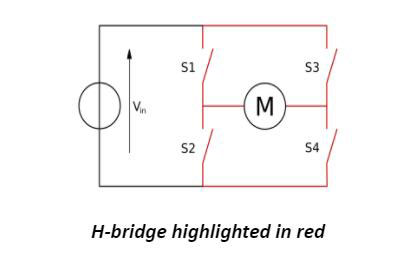Contents
What is L298?
L298 is a high current-high voltage dual full-bridge driver manufactured to operate inductive loads like stepping motors, relays, etc. It also receives standard TTL (Transistor-Transistor Logic) logic signals.
L298 dual H-bridge motor driver
Source; Wikipedia
In another definition, L298 is an integrated monolithic circuit in PowerSO20 and 15-lead Multiwatt packages.
It has two enable inputs that independently disable or enable a device attached at its output irrespective of input signals. Additionally, it regulates the rotating direction in DC motors.
L298 Pin Configuration
We are going to use a table to summarize the pinout of L298.
Characteristics of L298
Features or characteristics of L298 include;
- First, it has an operating supply voltage of up to 46V.
- Also, its total DC approximates 4A. Here, the continuous work current goes up to 2A, whereas the instantaneous peak current is 3A.
- Then, it has overtemperature protection via a freewheeling diode and high-capacity filter capacitor. The components limit the reverse current of an inductive load from reaching the device.
- Its storage temperature ranges from -40°C to 150°C, whereas its operating temperature is -23°C to 130°C.
- It has a low saturation voltage and a 25W rated power.
- Its noise immunity comes about due to a logical “0” input voltage approximating 1.5V.
- It also has socket pin connectors that help in easy logic interfacing.
- Finally, it can operate two DC motors, a four-phase stepper motor, and a two-phase stepper motor.
L298n Motor Driver
Generally, manufacturers use various L298n modules to make motor drivers. Examples include;

(l298n driver board module)
- L298 Dual H-Bridge Motor Driver
As mentioned before, it’s a high current, high voltage dual full-bridge driver often applicable in a double H driver module. The H-bridge controls the direction of rotating in DC motors.
- Motor Driver L298 Module
A motor driver L298 module regulates the direction and speed on 2 DC motors to about 40V 3A.
A separate power source powers up the motor, while a gadgeteer mainboard powers and controls the module during its operation.
- Grove – I2C DC Motor Driver
Its function is directly controlling a DC (two brushed) or Stepper motor (one 4-wire two-phase). At its center, there’s a dual channel H-bridge driver chip capable of withstanding approximately 2A current per channel.

(stepper electric motor)
An Atmel ATmega8L controls the chip and can manage I2C interfaces with platforms like Arduino. It can also simultaneously drive the stepper and DC motor in different directions and speeds.
How does the L-298 motor driver work?
The complete circuit diagram below explains the workflow of the internal structure in the L298n motor driver.
A schematic diagram of how the L298n motor driver works
The table below illustrates the states of motors one and two and their control mode.
Table Explanation
- First and foremost, control pin IN2 and IN1 (motor1), and pin IN4 and in3 (motor2) control the rotation direction.
- Then, if your enabled signal is 1;
- Motor A and motor B control become similar.
- IN2 is 0 while IN1 = anticlockwise rotation in motor A.
- IN2 is one, and IN1 is 0 = clockwise rotation in motor A.
- If IN2 and IN1 are 11 or 00 = a motor brake state.
- Furthermore, you can use PWM control pins like ENB for motor2 and ENA for motor1 to control motor speed. When using this method, ensure you confirm the output PWM pulses for enabled terminals and the direction of IN2 and IN1.
L-298 Motor Controller Interfacing with Arduino & DC Motor
Generally, an l298 dual H-bridge helps you spin a motor in both directions since you can switch the current direction. Moreover, you can incorporate an Arduino with PWN input to allow a motor to spin at any direction or speed.
Components needed
- Base Shield V2,
- 2×130 DC motor,
- Grove – i2C motor driver, and
- Seeeduino V4.2/ Arduino UNO
Steps
- Start by setting the address through the dial switch.
- Then, connect to the grove-base shield port a grove-I2C motor driver V1.3.
- Thirdly, insert your grove-base shield V2 into Seeeduino.
- Next, use a USB cable to connect your Seeeduino to the PC.
- Use the GitHub site to get the grove I2C motor driver V1.3 Library.

(GitHub platform)
- Afterward, install the Arduino library.
- Lastly, upload the copied code into the Arduino IDE. The code should resemble the one below;
Controlling DC motors
- The speed function keys set the desired motor speed. Examples include;
_speed; It stands for a settable speed. It can range from -100 to 100 (slowest to fastest). Also, <0 motor speed means an anticlockwise direction while >0 is a clockwise direction.
Motor_id; It represents motor types, i.e., motor one or two.
- In addition, we have a stop function that halts a running DC motor, for instance, MOTOR1/2.
L298 Applications
Some of the L298 applications include;
- Hobby projects,
- Engineering systems,
- Automatic door control systems,
- Robots and robotic arms,
- CNC machines,

(workshop with CNC machines)
- Measuring instruments,
- Relay drivers,
- Weight lifters,
- Industrial machines, and
- Vending machines.
L298 Compared with Other Motors
Undeniably, there are several motor drivers like stepper and servo motors in the markets.
Conclusion
As we conclude our article on l298n motor driver, we hope you’re more knowledgeable about the technology. However, if you still have questions or need further clarifications, kindly contact us. It’ll be our pleasure to help.





